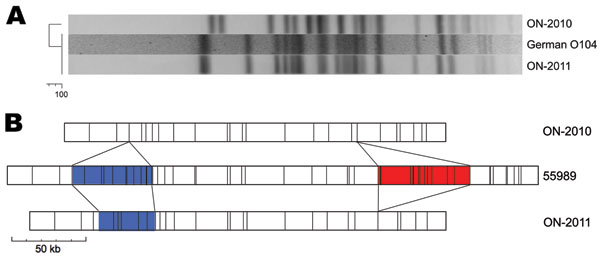Volume 18, Number 3—March 2012
Dispatch
Escherichia coli O104:H4 Infections and International Travel
Figure

Figure. Comparison of Escherichia coli O104:H4 isolates from Ontario. A) The XbaI pulsed-field gel electrophoresis profile of ON-2010 is distinct from those of ON-2011 and the outbreak strain from Germany. B) Optical mapping (NcoI) patterns reveal genomic similarities and differences between ON-2010, ON-2011, and the O104:H4 strain 55989. Blue, heterogeneity in siderophore biosynthesis region; red, strain-specific insertion of TetR-containing prophage.
Page created: February 02, 2012
Page updated: February 23, 2012
Page reviewed: February 23, 2012
The conclusions, findings, and opinions expressed by authors contributing to this journal do not necessarily reflect the official position of the U.S. Department of Health and Human Services, the Public Health Service, the Centers for Disease Control and Prevention, or the authors' affiliated institutions. Use of trade names is for identification only and does not imply endorsement by any of the groups named above.